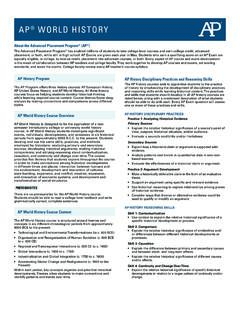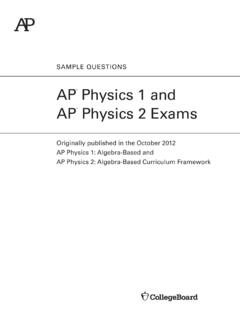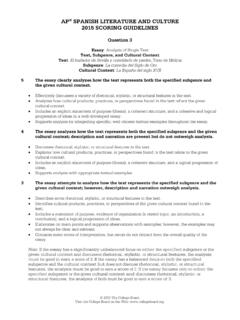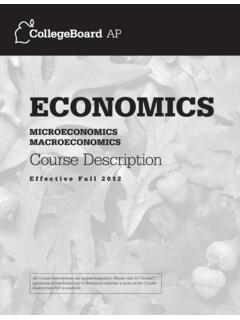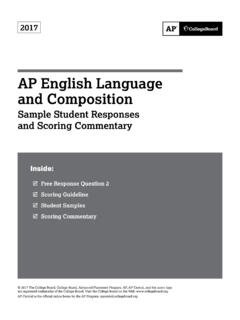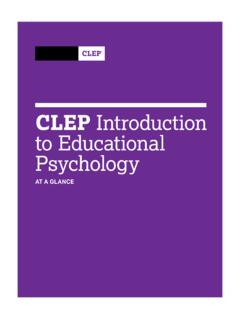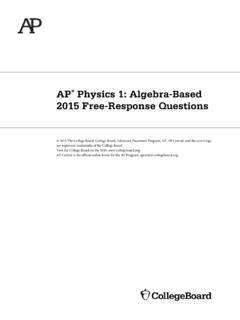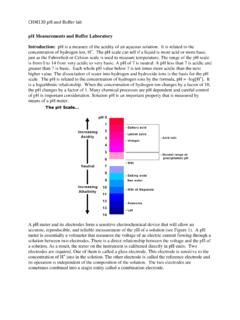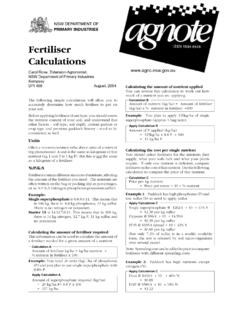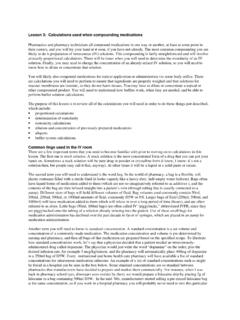Transcription of AP Chemistry 2017 Free-Response Questions - College Board
1 2017 AP Chemistry Free-Response Questions 2017 The College Board . College Board , Advanced Placement Program, AP, AP Central, and the acorn logo are registered trademarks of the College Board . Visit the College Board on the Web: AP Central is the official online home for the AP Program: -2- -3- Throughout the exam the following symbols have the definitions specified unless otherwise noted. L, mL = liter(s), milliliter(s) mm Hg = millimeters of mercury g = gram(s) J, kJ = joule(s), kilojoule(s) nm = nanometer(s) V = volt(s) atm = atmosphere(s)mol = mole(s)
2 ATOMIC STRUCTURE E = h c = E = energy = frequency = wavelength Planck s constant, h = 10 34 Js Speed of light, c = 108 ms 1 Avogadro s number = 1023 mol 1 Electron charge, e = 10 19 coulomb EQUILIBRIUM Kc = [C] [D][A] [B]cdab, where a A + b B R c C + d DKp = CDAB()()()()cdabPPPPKa = [H ][A ][HA] Kb = [OH ][HB ][B] Kw = [H+][OH ] = 10 14 at 25 C= Ka KbpH = log [H+] , pOH = log [OH ] 14 = pH + pOH pH = pKa + log[A ][HA] pKa = logKa, pKb = logKbEquilibrium Constants Kc (molar concentrations) Kp (gas pressures) Ka (weak acid) Kb (weak base) Kw (water)
3 KINETICS ln[A]t ln[A]0 = kt>@>@0AA11t = kt t = = rate constant t = time t = half-life AP Chemistry EQUATIONS AND CONSTANTS -4- GASES, LIQUIDS, AND SOLUTIONS PV = nRT PA = Ptotal XA, where XA = moles Atotal moles Ptotal = PA + PB + PC + .. n = mM K = C + 273 D = mV KE per molecule = 12mv2 Molarity, M = moles of solute per liter of solution A = abc P = pressure V = volume T = temperature n = number of moles m = mass M = molar mass D = density KE = kinetic energy v = velocity A = absorbance a = molar absorptivity b = path length c = concentration Gas constant.
4 R = J mol 1K 1 = L atm mol 1K 1 = L torr mol 1K 1 1 atm = 760 mm Hg = 760 torr STP = K and atm Ideal gas at STP = L mol 1 THERMODYNAMICS / ELECTROCHEMISTRY q = mc T S = productsreactantsSS DD H = productsreactantsffHHDD DD G = productsreactantsffGGDD DD G = H T S = RT lnK = n E I = qt q = heat m = mass c = specific heat capacity T = temperature S = standard entropy H = standard enthalpy G = standard Gibbs free energy n = number of moles E = standard reduction potential I = current (amperes) q = charge (coulombs) t = time (seconds)
5 Faraday s constant, = 96,485 coulombs per mole of electrons 1 volt =1 joule1 coulomb 2017 AP Chemistry Free-Response Questions 2017 The College Board . Visit the College Board on the Web: GO ON TO THE NEXT PAGE. -5- Chemistry Section II 7 Questions Time 1 hour and 45 minutes YOU MAY USE YOUR CALCULATOR FOR THIS SECTION.
6 Directions: Questions 1 3 are long Free-Response Questions that require about 23 minutes each to answer and are worth 10 points each. Questions 4 7 are short Free-Response Questions that require about 9 minutes each to answer and are worth 4 points each. Write your response in the space provided following each question. Examples and equations may be included in your responses where appropriate. For calculations, clearly show the method used and the steps involved in arriving at your answers. You must show your work to receive credit for your answer.
7 Pay attention to significant figures. CS2(g) + 3 Cl2(g) CCl4(g) + S2Cl2(g) 1. Carbon tetrachloride, CCl4(g) , can be synthesized according to the reaction represented above. A chemist runs the reaction at a constant temperature of 120 C in a rigid L container. (a) Chlorine gas, Cl2(g) , is initially present in the container at a pressure of atm. (i) How many moles of Cl2(g) are in the container? (ii) How many grams of carbon disulfide, CS2(g) , are needed to react completely with the Cl2(g) ? (b) At 30 C the reaction is thermodynamically favorable, but no reaction is observed to occur.
8 However, at 120 C, the reaction occurs at an observable rate. (i) Explain how the higher temperature affects the collisions between the reactant molecules so that the reaction occurs at an observable rate at 120 C. (ii) The graph below shows a distribution for the collision energies of reactant molecules at 120 C. Draw a second curve on the graph that shows the distribution for the collision energies of reactant molecules at 30 C. 2017 AP Chemistry Free-Response Questions 2017 The College Board . Visit the College Board on the Web: GO ON TO THE NEXT PAGE.
9 -6- (c) S2Cl2 is a product of the reaction. (i) In the box below, complete the Lewis electron-dot diagram for the S2Cl2 molecule by drawing in all of the electron pairs. Cl S S Cl(ii) What is the approximate value of the Cl S S bond angle in the S2Cl2 molecule that you drew inpart (c)(i) ? (If the two Cl S S bond angles are not equal, include both angles.) (d) CCl4(g) can also be produced by reacting CHCl3(g) with Cl2(g) at 400 C, as represented by the equation below. CHCl3(g) + Cl2(g) CCl4(g) + HCl(g)At the completion of the reaction a chemist successfully separates the CCl(g)4 from the HCl(g) by cooling the mixture to 70 C, at which temperature the CCl4(g) condenses while the HCl(g) remains in the gaseousstate.
10 (i) Identify all types of intermolecular forces present in HCl(l). (ii) What can be inferred about the relative strengths of the intermolecular forces in CCl4(l) and HCl(l) ? Justify your answer in terms of the information above. 2017 AP Chemistry Free-Response Questions 2017 The College Board . Visit the College Board on the Web: GO ON TO THE NEXT PAGE. -7- 2. Answer the following Questions about the isomers fulminic acid and isocyanic acid. Two possible Lewis electron-dot diagrams for fulminic acid, HCNO, are shown below.
